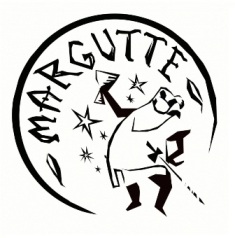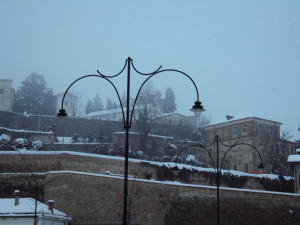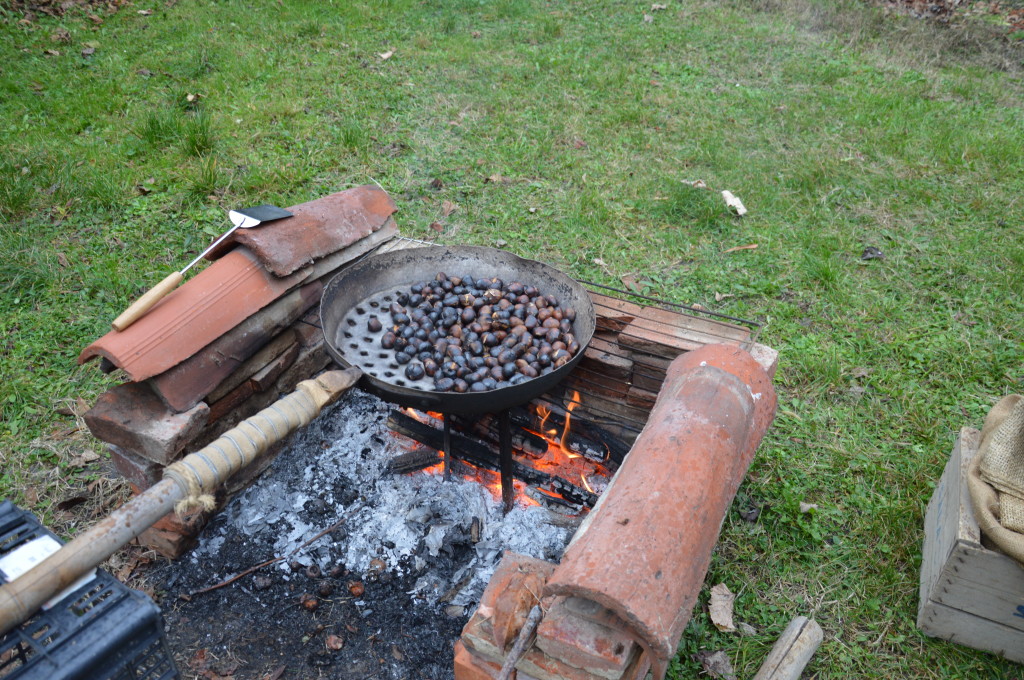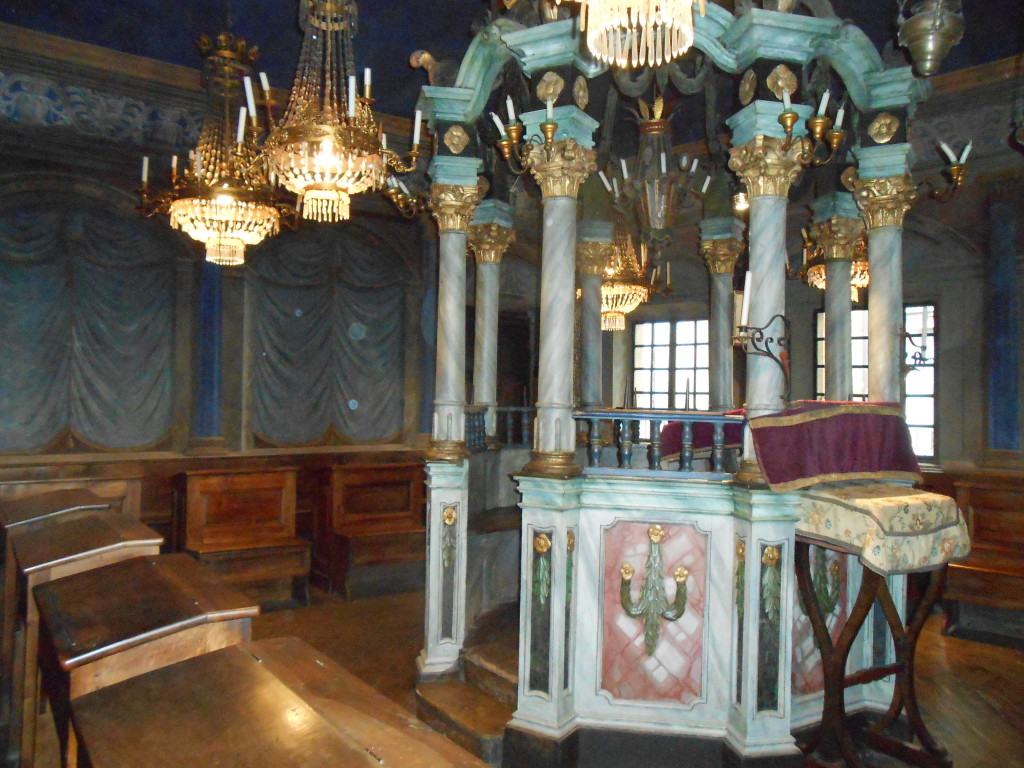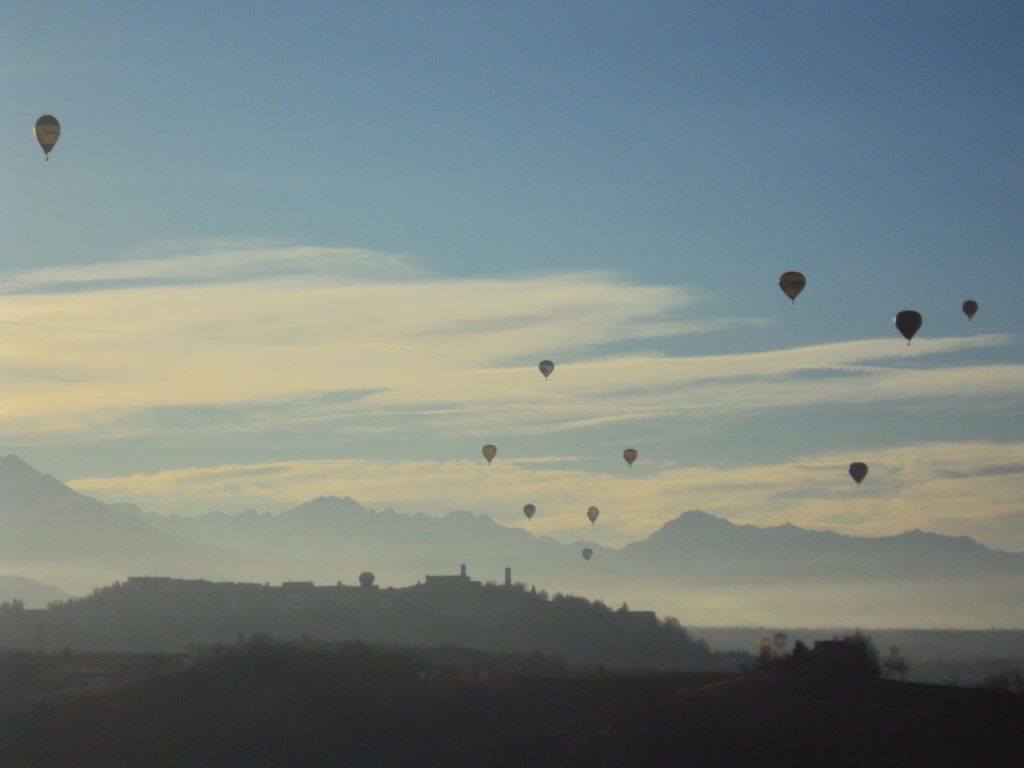 LESLIE MCBRIDE WILE
LESLIE MCBRIDE WILE
A year is ended, a year begins
On the second-to-last day of the year we took a drive to Rocca Ciglie, a little dot on the map we’d never visited before. With its castello, medieval tower, and substantial church, Rocca Ciglie is much like many other hill towns in Piemonte. But its specific charm lies in its location on a ridge between two Alpine ranges, the Alpi Marittime that lie between us and the Mediterranean to the south and the Alpi Graie, which form the border between Italy and France to the west, Switzerland and Austria to the north.
We found long views in all directions; a slight haze over the mountains turned everything blue, even the snow cloaking the highest peaks. The day was sunny and warm enough that we loosened coats and scarves and shed our hats while we sat on the porch of a little chapel dedicated to San Bernardo, lunching on cheese and tomatoes. Rose bushes beside of the porch stairs bristled with bright red fruit and a few drooping flowers, dried now along the edges. We walked afterward on trails and farm roads that were by turns muddy, stony, or thick with frosted grass. Breathing the scents of earth and manure, squinting against the sun, it was a good day to be alive.
The year 2012 was one of upheaval and loss and seemingly endless transition. It was also a year of exploration and discovery, liberation and possibility; the year we rode the roller coaster together (literally, in the park at Borjomi Springs, the first day of our journey from Georgia to Italy) and walked away laughing and gasping at our own daring. We began 2012 in Tbilisi, celebrating at home with new friends, and we finished the year in much the same way–eating, talking, laughing for hours with new friends, this time in Mondovi. We’re down off the roller coaster for the moment; moving on together, still laughing every day and curious to see what the new year will bring. Happy New Year
Mongolfiere over Mondovi
At the end of a week of unseasonably warm, clear days the skies above Mondovi filled with brightly colored orbs that floated gently overhead—le mongolfiere sono arrivate! The annual hot-air balloon festival brought nearly 30 ballooning teams from all over Europe to Mondovi for two days. (The Italian word for hot-air balloon is “mongolfiera,” after the 18th-century inventors of the craft, the brothers Mongolfier.)
The staging area was in the lower town, in a small park surrounded by apartment blocks, and it was amazing to see how little space the crews needed to inflate and launch the great things. Jim and I chatted awhile with one group of English balloonists who live not far from Mondovi, and they were so jolly that we sort of adopted them—they became “our team” to watch for on the ground and in the air. We chased them (in Dora the Explorer) across the hills around town for most of Saturday afternoon, picked them out of the crowd on Sunday morning and tracked their progress until they landed just before dusk on Sunday evening.
The mongolfiere added one more element of magic to this picturesque town—colorful globes suspended in the spring-like breeze, with the medieval piazza and the Alps beyond. I hope you enjoy this glimpse at some of the sights that made us especially happy all weekend.
In the blue shadows
Snow all day on Saturday, beginning just as we left for the big market down in Breo and continuing until after dark. We wanted to visit our house in the hush of snowfall, but thought better of it when the wind picked up, drawing a billowy white curtain across the view from our apartment balcony. Instead we stayed indoors, made a fish soup with cozze (mussels) and fresh merluzzo (cod), potatoes, fennel, saffron.
Sunday we woke to bright sunlight and the sound of snowmelt dripping from the eaves. Pulled on our boots and went out to meet the sparkling day. By now the little house and walled courtyard are familiar to you; probably I could leave off the photo captions altogether. But look closely at the doorway with a terra cotta pot in the lower left corner: at first glance I thought some elves must have left us a pot of my favorite vermilion pansies! Then I saw the others, lining the stairway, and I began to understand what Jim finds to do during the long hours he spends there.
Before we knew it, blue shadows lengthened toward afternoon. The sunlight cooled and thinned, reminding us the days grow ever shorter, the sun rides lower in the sky. We locked up and climbed the steep road out of the valley, toward a late lunch and the Sunday NYTimes crossword.
Piccola castagnata
There’s always something food-related going on here–in Piemonte it seems the seasons exist to bring on the next good thing to eat. After the bounty of summer comes funghi season, the woods all around full of foragers with baskets over their arms, hunting wild porcini mushrooms. Tartufo season follows, but truffle hunters tend to be a bit more secretive, pretending to be out for a casual walk with the dog, who has a nose for locating the fragrant nuggets at the base of certain trees. Tartufi are a rare and precious delicacy, and those who know where to find them guard their sources closely.
Now we’ve come to the castagnata, or caldarroste–the ritual of roasting chestnuts. Chestnut trees grow everywhere and the nuts are thick on the ground–you can pick up kilos during a walk in the woods. Some friends who actually cultivate a few trees gave us a huge sackful, and we roasted them on Sunday with our friend Paolo.
Paolo brought the padella, a big, heavy pan with perforations that allow the nuts to roast over an open fire, and instructed us in the ways of the castagnata:
Prepare the chestnuts by cutting a small slit in each shell. This prevents the nuts from bursting when exposed to extreme heat. (Well, that’s the theory. We had a few nuts burst, leaping out of the skillet like popcorn.)
While roasting, toss the chestnuts in the padella so they cook evenly. After 20-30 minutes, when the shells are blackened and the nuts are caramelized, with a texture like a perfect baked potato, pour them into a burlap sack to keep them warm.
Slip the chestnuts from their shells as soon as you can handle them without burning your fingers; while they are warm eat as many as you can–rich, sweet, and smoky, few other things are as delicious. The traditional accompaniment is vin brule’, mulled wine with spices, but we had a thermos of espresso instead.
Historic Synagogue, Mondovi
Sunday, 29 September 2013 was designated “la giornata europea della cultura ebraica,” or European Day of Jewish Culture. On this special occasion, in Italian towns and cities from Asti to Venezia, Jewish historic and cultural sites are open to the public. This includes the historic synagogue at via Vico 65, a few doors down from our first apartment in Mondovi. For a full year we lived just steps away from this treasure, which is normally open by appointment only, but just today we spent 30 minutes touring the sanctuary, women’s gallery, and children’s classroom. I’m sending some photos to share (see attached file below my signature), and will give just a few points of information from our tour. (Thanks to my friend and former Hillel colleague, JB, for the following link with a fuller history of the synagogue: http://synagogueartresearch.wordpress.com/countries/italy/mondovi/
The synagogue occupies the third (top) floor of a small apartment building, and we were asked to keep silent on the stairs out of respect for the residents. As you can see from a photo of the floor plan, the sanctuary is irregularly shaped, with the door at the rear, the pulpit in the center, and the ark at the far side of the room. Markings on the pulpit indicate it may have been re-assembled after moving from a previous location. Simple wooden benches run along three walls, which are painted with trompe l’oile blue draperies. The carved and gilded wooden doors of the ark are curtained with heavy silk, thought to be original 18th-century furnishing. The rest of the synagogue comprises a women’s gallery, completely separate from the sanctuary, a small classroom for children, and a balcony, now enclosed, with views to a green valley below the city ramparts.
The Mondovi ghetto of the mid-18th century consisted of a few houses and a common courtyard, perhaps from number 65 to number 59 via Vico. During the 19th century, as many as 150-200 people lived in this tiny enclave. By law, no identifying sign or symbol could show passersby that behind the houses a small Jewish community existed, seeking to live in peace and relative safety.
Pictures by Leslie McBride Wile, an American who lives in Mondovì.
